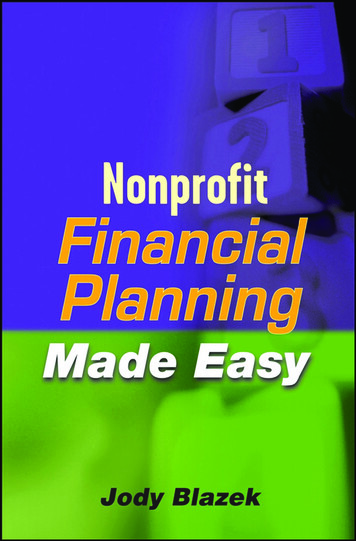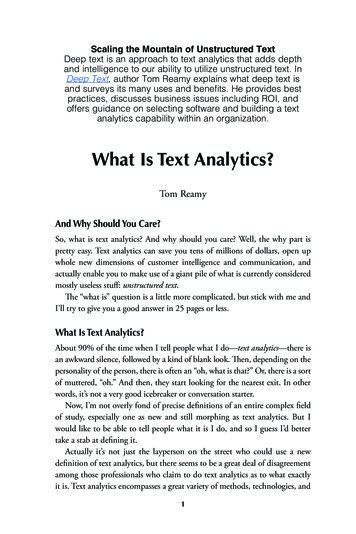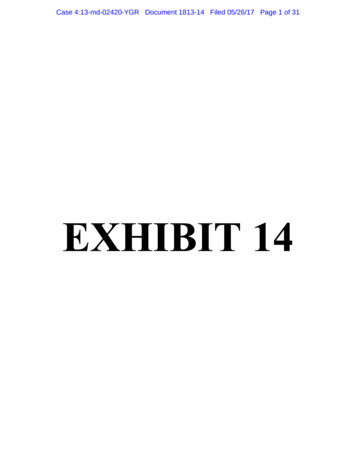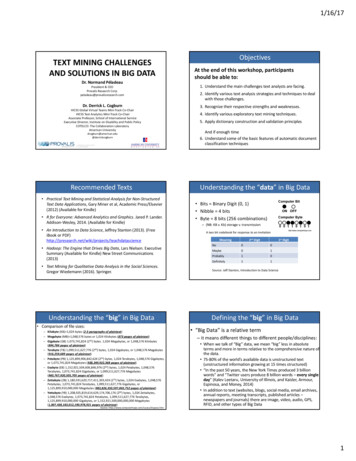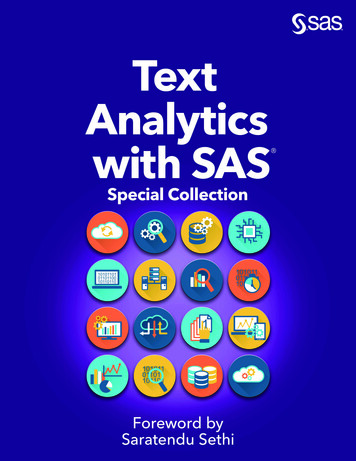
Transcription
The Adaptations of Augie March: A Novel by Saul Bellow, A Play by David Auburn, A Production by CharlesNewell, An Exhibit by Special Collections and Court TheatreApril 29, 2019 through August 30, 2019Exhibit TextExhibit Introductory Panel:In 1953, Saul Bellow published The Adventures of Augie March, the story of a young immigrant comingof age in Chicago and discovering his identity as a writer. The novel launched Bellow’s reputationand established the future Nobel Laureate's literary renown.In 2015, Court Theatre Artistic Director Charles Newell commissioned the Pulitzer Prize-winningplaywright David Auburn, AB ‘91, to adapt The Adventures of Augie March for Court’s stage. The sameyear, the Special Collections Research Center began processing and cataloguing Saul Bellow’s papersfor use by scholars, students, and researchers.The Adaptations of Augie March examines the successive transformations of Bellow's original text inthe hands of playwright Auburn and his collaborator Newell as they worked closely with a team oftheatre artists—including a set designer, costume designer, choreographer and dialect coach—tobring the May 2019 world premiere of The Adventures of Augie March to life at Court Theatre.Among the manuscripts and artifacts on display here are early handwritten drafts of Bellow’s noveland his later revisions; original drafts of David Auburn’s play; Charles Newell’s artistic notes andplans for establishing the world of the play; costume designer Sally Dolembo’s drawings andsketches; the mind-bending work of shadow puppetry collective Manual Cinema, commissioned byCourt to generate the play’s special effects; and John Culbert’s minimalist, non-literal design for a setcapable of evoking places as disparate as Depression-era Chicago, the mountains of Mexico, postWWII Italy, and a lifeboat on the open ocean.The exhibit invites visitors to step into the world of Augie March—as Bellow imagined it, as Auburnadapted it, and as Newell envisioned it for the stage. The Adaptations of Augie March illuminates howwriters and theatre artists work together to create and build the world of a play, and how they bringthat world to full realization using the tools and elements of live performance.Dramaturgical EssayFIRST TO KNOCK, FIRST ADMITTED:The Adventures of Saul BellowImmigrantSaul Bellow arrived with his family in Chicago on July 4, 1924, smuggled by bootleggers across theborder from Canada. He was nine years old. He would remain an “illegal alien”—we would now say,“undocumented immigrant”—until the age of 27.
Bellow was born in 1915 in Lachine, Quebec. His parents were Russian Jews. They had originallycome to Canada to flee anti-Semitic violence and political persecution in their home city of St.Petersburg, Russia.The Bellow family arrived on American soil two short months after the U. S. Congress passed the1924 Immigration Restriction Act, a drastic and sweeping revision of federal immigration policy.The new law slammed the door on a mass of humanity that had been flowing to America since thelate 19th-century, ending the greatest era of unrestricted migration to the United States in its history.From 1880 to 1924, waves of newcomers, primarily from Southern and Eastern Europe. poweredthe rapid growth of Chicago. The city’s population quadrupled in thirty years’ time, growing from500,000 residents in 1880 to over 2 million in 1910. By 1924, when Bellow took up residence withhis family in the Russian Jewish enclave of Humboldt Park, 70% of Chicago residents were foreignborn or the children of foreign-born parents.His whole life, Bellow retained a vivid impression of the first day he spent in America: July 4, 1924.He recalled his nine-year-old self thinking the fireworks, flags, bunting and parades of IndependenceDay were for him, meant to hail the promise of his new life in America.But the 1924 Immigration Restriction Act told a less welcoming story. The law was informed by theburgeoning eugenics movement, which maintained that peoples from Southern and Eastern Europe,Latin America, Asia and Africa were genetically inferior to those from Northern and WesternEurope. The 1924 Act accordingly slashed immigration rates from targeted nations by 98%, barringadmission to Russian Jews, Poles, Hungarians, Bulgarians, Italians, Greeks, Mexicans, Chinese,Turks, Armenians, Lithuanians and Africans, among many others. Conspicuously, the 1924 Act leftthe door open to migrants from Great Britain, Ireland, Denmark, Germany, Sweden and Norway.Eugenicists celebrated the 1924 Act as a measure that would “preserve the purity of Americanstock” by welcoming immigrants only “of higher intelligence,” who thus presented “the bestmaterial for American citizenship”. The now-excluded categories of people, it was believed, had“made an excessive contribution to our insane, criminal and other socially inadequate classes.” Arelated federal act prohibited entry to “epileptics and insane persons; paupers; professional beggars;persons likely to become a public charge; persons afflicted with a loathsome or dangerous disease;and persons who have committed a felony or other crime involving moral turpitude.” Polygamists,prostitutes and those with “mental or physical defects which might affect their ability to earn aliving” were also banned.A natural reading of The Adventures of Augie March views it as Bellow’s artistic response to thecontradictions inherent in the historical moment of his arrival in this country.The story Bellow scrawled, beginning in 1947, in a succession of battered notebooks—notebooksnow housed in the Special Collections Research Center—charts the coming of age of a youngundocumented immigrant amidst the foreign-born multitudes of Chicago. Augie, Bellow’s narrator,struggles amongst the plenty and poverty of the city toward self-knowledge. He achieves it at last indiscovering his identity as an American writer.Bellow’s novel offers a rejoinder to the premise that a person’s country of origin, physical form ornatural endowments determine their fitness for American life. The characters peopling TheAdventures of Augie March hail from the countries of origin marked for exclusion by the 1924Immigration Restriction Act: they are Russian Jews, they are Mexican, they are Hungarian and
Polish, they are Czech and Italian. They may be paralyzed, blind, physically disabled, or “insane.”They are relegated to the poverty-stricken and criminal margins of the city’s teeming social world.Invariably they are the “socially inferior.” But they are unmistakably American, and they contributeto the vibrant day-to-day of an unmistakably American city.WriterAugie is not quite Bellow’s alter ego. But his life echoes aspects of Bellow’s life, and his impressionsand experiences are often artful silhouettes of Bellow’s own. Above all, the language Bellow uses torecount Augie’s adventures bears the unique and unmistakable stamp of the city that shaped him.As a child coming of age on the streets of Chicago, Bellow absorbed a rich inheritance. His earliestspoken languages were Russian and Yiddish. He picked up English on Chicago’s West Side, wherehe played alongside the children of recently-arrived Poles, Italians, Swedes, Greeks, Hungarians,Czechs and Romanians. Bellow remembered these immigrant youths being as eager as he was to talkabout distinctly American things: “baseball, prizefights, speakeasies, graft, jazz, crap games, gangwars.” As an adolescent, Bellow drew inspiration from soapbox preachers on Division Street,vendors hawking wares in the Maxwell Street Market, and speeches by orators, labor leaders andpoets who assembled for debates in Bughouse Square, the park beside the Newberry Library. Hehaunted the stacks of multiple branches of the Chicago Public Library, where classic texts of worldliterature were freely available to him, the son of a low-wage employee at a kosher bakery onAugusta Avenue.These multitudinous influences are evident in the language Augie March uses to tell his story.Inflected with Yiddish rhythms, salted with slang and idiomatic speech, packed with interludes ofheightened poetic phrasing and allusions to high culture, Augie’s narrative voice immerses readers inthe colloquial language of the Chicago streets. One of the signal achievements of The Adventures ofAugie March, according to the writer Philip Roth, was how the novel raised “the language you spoke,the American argot you heard on the street,” to the level of high literature.Augie’s narrative voice even keeps pace with the evolution of Chicago street speech over threedecades. As the chapters proceed the music of the language shifts from the rhythms of theProhibition-era vernacular, to the minor key changes of the Great Depression in the 1930s, to thegrander tones of the 1940s heralding the post-war economic boom.The idea for a novel that channeled the music of Chicago vernacular speech came to Bellow whenhe was living in Paris in 1947. One morning, watching city workers opening the valves of hydrantsto allow the gushing water to sweep clean the pavements, he asked himself, “why not have as muchfreedom of movement as this running water?” The flowing hydrants conjured the sudden memory,Bellow said, of “a handsome, free-wheeling kid from childhood whose surname was August, andwho used to yell when we were playing, ‘I got a scheme!’” Recreating the energy and brio of hislong-ago Chicago friend was the start of Augie March: “Subject and language appeared at the samemoment—I was enriched with words,” Bellow recalled. “I found myself with magical suddennesswriting the first paragraph. It rushed out of me.” The novel’s language came to his mind so swiftly,he remembered, “All I had to do was be there with buckets to catch it.”MythologistWhile Bellow transmuted the phrasings and cadences of Chicago’s immigrant residents into a newkind of heightened literary language, he also likened their personhood to figures of myth and history.
The cast of characters populating Augie’s street-level world are compared to gods and heroes ofGreek mythology, or heroes from the annals of world history.Simon, Augie’s body-building older brother, is afflicted with bouts of insanity like his mythologicalcorrelate, Hercules. The orating, wheelchair-using real estate broker William Einhorn is at onceequated with Hephaestus, the blacksmith God of Invention, and President Franklin Roosevelt.Grandma Lausch, physically infirm but ruthlessly tyrannical, is compared to Emperor Timur, the14th-century conqueror of Asia and heir to Genghis Khan. Rebecca March, Augie’s blind,incapacitated mother stands with the many mortal women in Greek mythology who, seduced andabandoned by Zeus, give birth to demigods. Augie himself is likened to Alcibiades, legendary oratorof 5th-century B.C.E. Athens, beloved by the gods for his charisma and gift of self-expression.Bellow suggests gods and geniuses walk the streets of Chicago, reincarnated as immigrants andworkers. With immigrants from the “old world” no longer free to enter America, this promise isforestalled. Bellow begins the novel with a quote from Heraclitus, the 5th-century B.C.E.philosopher: Heraclitus says that “a man’s character is his fate”— not race, ethnicity or physicalendowments.The publication of The Adventures of Augie March in 1953, when he was 38 years old, launched SaulBellow’s reputation as a novelist and established the future Nobel Laureate’s literary renown.Congress, meanwhile, would not end the exclusionary quota system imposed by the 1924Immigration Restriction Act until 1965. The opening lines of Augie March --I am an American, Chicagoborn—Chicago, that somber city—and go at things as I have taught myself, freestyle, and will make the record in myown way: first to knock, first admitted; sometimes an innocent knock, sometimes a not so innocent—stand asBellow’s testament to the liberating potential of the American immigrant experience.--Nora TitoneExhibit AcknowledgementsThe Curators—Moyo Abiona, Patti Gibbons, Emily Lynch, Daniel Meyer, and Nora Titone—wishto thank the College Center for Research and Fellowships, and the following people for their kindcontributions to the exhibit:Stephen J. AlbertBarbara GilbertDavid AuburnAshley GosselarJanis Freedman BellowDiana HarperLeigh BienenAbigail HenkinJohn BoyerLauren Kincaid-FilbeyTraci BrantZachary LeaderChristine ColburnJonathan LearJohn CulbertMichael LittZac DavisEmily LovettDrew DirJoe MazzaSally DolemboPascal MerighiBrent Ervin-EickoffThusnelda MercyNichole FazioJulia MillerSarah FornaceCharles Newell
Carolyn OwnbeyJessica SeetCecilia SmithHeidi Thompson SaundersCatherine UeckerSonya WangChristopher WildAngel YsaguirreSusan ZellnerCASE: “I AM AN AMERICAN, CHICAGO BORN”A young immigrant arrives in ChicagoNine-year-old Saul Bellow arrived in Chicago on July 4, 1924, when bootleggers smuggled the boyand members of his family across the border from Canada. He would remain an illegal alien in theUnited States until 1943, when he became a naturalized citizen. Saul Bellow was born in 1915 inLachine, Quebec to Russian Jewish parents, Abraham and Lescha Bellow, who themselves came toCanada in 1913, fleeing anti-Semitic violence and political persecution in their home city of St.Petersburg, Russia. For the rest of his life, Bellow retained a vivid impression of the first day hespent in the city of Chicago. He remembered believing that the fireworks, flags, bunting and paradesof the 1924 Independence Day celebrations were intended to welcome him, and to hail the promiseof his new life in America.A novel and a fictional character born from Bellow’s experiences in the cityBellow later said his childhood on the streets of Chicago supplied the electric charge of inspirationfor The Adventures of Augie March. Bellow’s widow, Janis Freedman Bellow, connects the exuberanceand brio of the novel’s language to the intoxicating freedom and creative energy Bellow firstdiscovered as new arrival in this city. When Bellow set out to write the story of a young immigrantcoming of age in Chicago, he adapted aspects of his own life when crafting the narrative. AugieMarch is neither Bellow’s alter ego nor his double, but rather, he is a character whose adventures—through the alchemy of the author’s literary imagination—distantly echo aspects of Bellow’s life, andwhose impressions and substantive experiences at times are artful silhouettes of Bellow’s own. AsJanis Freedman Bellow has remarked, “When pieces of [Bellow’s] life find their way into his work,there is always something magical about the manner in which they are lifted from the past orpresent, kneaded and shaped and subtly transformed into narrative. But this is not cutting andpasting of actual events: Saul wields a wand, not a scissors.”The genesis of The Adventures of Augie MarchSaul Bellow began writing the novel when he was living in Paris on a Guggenheim Fellowship. Onespring morning in 1949, he recalled, the sight of Parisian street sweepers releasing the valves onwater hydrants to send a flood across the cobblestones suddenly unlocked his imagination: “Iremember saying to myself, ‘Well, why not have as much freedom of movement as this runningwater I seem then to have gone back to childhood in my thoughts and remembered a pal of minewhose surname was August—a handsome, free-wheeling kid who used to yell out when we wereplaying checkers, ‘I got a scheme!’” Thinking of this childhood friend, and of the Chicago he hadknown growing up in the 1920s-1930s, Bellow conceived of the novel in an instant: “Subject andlanguage appeared at the same moment. The language was immediately present—I can’t say how ithappened, but I was suddenly enriched with words and phrases I found myself with magicalsuddenness writing a first paragraph It rushed out of me. I was turned on like a hydrant insummer.” The notebooks Bellow used to catch this flood of inspired language are found throughoutthis exhibit.
Certificate of Naturalization, 1943Saul Bellow PapersU.S. Passport, 1951Saul Bellow PapersAffidavitSaul Bellow PapersThis affidavit is witnessed by Samuel Freifeld, Bellow’s classmate and intimate friend from Chicago’sTuley High School. Freifeld’s father, Ben Freifeld, served as a model for the character WilliamEinhorn in The Adventures of Augie March.Typescript Fragment, The Adventures of Augie MarchChapter 1, pages 1-2Zachary LeaderThe Life of Saul Bellow: Love and StrifeNew York: Knopf, 2015PS3503.E4488Z736 2015 c.2 ArcMonThe William Vaughn Moody Collection in American LiteratureSaul Bellow and family, photographed in Lachine, Quebec in 1918, six years before they crossed theborder illegally to take up residence in Chicago. From left to right, four-year-old Saul, his motherLescha, his brothers Maury and Sam, and his sister Jane.[Reproduction]Photo, 1920Getty ImagesAn Independence Day parade processes across the Michigan Avenue Bridge, July 4, 1920. SaulBellow witnessed a similar city-wide festival when he, his mother and siblings first arrived inAmerica, disembarking from a train at Chicago’s Harrison Street Station on the Fourth of July, 1924.[Reproduction]Photo, 1928Chicago History Museum, DN-0086118Children play in water spraying onto the street from an open hydrant in Chicago’s West Town, 1928.Saul Bellow told his friend Philip Roth that the sight of a hydrant gushing water onto the streets ofParis in 1949 so vividly brought to mind memories of his freewheeling Chicago childhood, that theimage unlocked his imagination and inspired him to write The Adventures of Augie March.[Reproduction]Photo, c. 1915Chicago History Museum, in Culter’s Jewish Chicago F548.9.J5C88 2000 GenAdolescent boxers in training strike pugnacious poses outside the Chicago Hebrew InstituteGymnasium. Scenes like this offer a glimpse of the social world that welcomed young Saul Bellowwhen he and his family settled in Chicago’s Humboldt Park in 1924.[Reproduction]
Photo, c. 1915Jewish Federation of Metropolitan Chicago, in Culter’s Jews of Chicago F548.9.J5C870 1996 GenGirls participate in a dance class at the Jewish Training School of Chicago, a thriving institutionfounded in 1888 to provide English lessons, vocational training and arts instruction to the childrenof Russian Jewish immigrants on Chicago’s West Side.CASE: NOBELDay PlannerBellow’s day planner with Nobel Prize ceremony marked on December 10, 1976[Reproduction]Newspaper ClippingUnited Press InternationalDecember 11, 1976Saul Bellow PapersBooklet“Translation of the Speeches at the Nobel Festival 1976”Saul Bellow PapersCASE: HOW CHICAGO SHAPED BELLOW AS A WRITERThe Viking Press published The Adventures of Augie March in 1953 to widespread acclaim. One of thenovel’s achievements, Philip Roth observed, was raising “the language you spoke, the Americanargot you heard on the street,” to the level of high literature. Bellow’s Augie, like Mark Twain’sHuckleberry Finn, is the narrator of his own life story. Bellow said the shape of his novel was like “awidening spiral that begins in the ghetto and the slum and spreads into the greater world, and thereAugie comes to the fore because of the multiplication of people around him and the greaterdifficulty of experience.” Though Augie travels far—his story leaps from Mexico to New York, Italyand a lifeboat in the middle of the Atlantic Ocean—he begins in Chicago, and the language he usesto recount his adventures bears the unique and unmistakable stamp of his city of origin. Inflectedwith Yiddish rhythms, salted with slang and idiomatic speech, packed with interludes of heightenedpoetic phrasing and allusions to high and low culture, Augie’s narrative voice immerses readers inthe colloquial lyricism of the Chicago streets. As the novel’s spiral widens, and Bellow’s protagonistgains in age and experience, Augie’s language keeps pace with the evolution of Chicago speech overthree decades, evoking the vernacular of the Prohibition era, tracking the minor key changesheralded by the Great Depression, and finding the tonal shift that marked the years of the post-wareconomic boom.As the manuscripts and oral history interviews displayed indicate, Bellow absorbed a rich inheritanceas a writer in the years he spent coming of age in Chicago.Though his earliest spoken languages were Russian and Yiddish, he picked up English on the streetsof Chicago’s West Side, where he played alongside the children of Poles, Italians, Swedes, Greeks,Hungarians, Czechs and Romanians. Bellow remembered his playmates being as eager as he was toditch their native tongues and talk exclusively on American themes--“baseball, prizefights,
speakeasies, graft, jazz, crap games, gang wars.” The adolescent Bellow heard soapbox preachers onDivision Street, tuned his ear to the cacophony of vendors hawking wares in the Maxwell StreetMarket, and drank in the words of orators, labor leaders and poets who assembled for debates inBughouse Square, the tree-shaded park beside the Newberry Library. He haunted the stacks ofmultiple branches of the Chicago Public Library system, where classic texts of world literature werefreely available to him, the son of a low-wage employee at the Imperial Bakery on Augusta Avenue.Later, as a student at Tuley High School in the 1930s, Bellow and his classmates toiled on theeditorial boards of school literary magazines and newspapers, churning out ambitious works oforiginal fiction, poetry and essays.Bellow published two novels prior to Augie, The Dangling Man in 1944 and The Victim in 1947. Thelanguage of those early works in no way resembled what he achieved with Augie. Zachary Leader,Bellow’s biographer, explains that the novelist “knew that he was doing something new with TheAdventures of Augie March. What he discovered with Augie, Bellow later told Philip Roth, was “that Icould write whatever I wished, and that what I wished was to get into words the appearance of agallery of personalities—characters like Grandma Lausch or Einhorn the fertile cripple, or AugieMarch himself. Years of notation ended in the discovery of a language that made everythingpossible.”Saul BellowThe Adventures of Augie MarchNew York: Viking, 1953PS3503.E436A67 1953 c.7 Rare616686217[Reproduction, detail]MapCram's City Guide Map of Chicago, c. 1926G4104.C6 Regenstein Map CollectionSpeech, 1972“Chicago and American Culture: One Writer’s View”Saul Bellow PapersThese are the first two pages of a speech Saul Bellow gave at Chicago Public Library.Holograph Draft, undated“How, In the City of Chicago does a Young Person Become a Writer”Saul Bellow Papers[Reproduction]Photo, undatedBughouse SquareWashington Square Park, ChicagoWikimedia CommonsiPad: Oral Histories
Recorded oral history interviews with Julius Echeles and David Peltz, Saul Bellow’s high schoolclassmates who grew up with him in Humboldt ParkDavid Peltz Interview (00:00-1:07:13)00:16 - 04:16 - Peltz's childhood and early recollections of Saul Bellow04:17 - 06:51 - Reading books at a young age06:52 - 10:19 - The Freifeld family10:21 - 14:15 - Saul Bellow and Nelson Algren14:19 - 15:35 - Tuley High School15:35 - 16:34 - Bellow's family after the death of his mother16:34 - 18:01 - Bellow's family on his career as a writer18:03 - 18:22 - Bellow and Jewish identity20:03 - 22:31 - Bellow as a Chicago WriterJulius Echeles Interview (1:07:13 - end)1:07:13 - 1:09:10 - Recollections of Tuley High1:09:11 - 1:11:47 - The success of the Dangling Man1:11:47 - 1:18:22 - Tuley High School and the Depression1:18:23 - 1:21:01 - Demographics of Humboldt Park1:21:02 - 1:22:56 - Extracurricular activities in high school1:22:57 - 1:26:31 - Echeles' childhoodCASE: AUGIE MARCH 1953 PUBLICATION & REVIEWSThe publication of The Adventures of Augie March by the Viking Press in 1953 won Saul Bellownational recognition and an immense public readership, launching him to fame and fortune. Reviewsof the novel in major publications hailed Bellow as an American literary talent worthy of comparisonto Mark Twain, Stephen Crane, Theodore Dreiser, and John Dos Passos. The novel sold briskly. In1954, Augie was awarded the National Book Award for Fiction. The spotlight of literary celebrityshone brightly on 39-year-old writer Bellow, who had succeeded, he wrote privately to a friend, in“proving that a young man from Chicago had the right to claim the world’s attention.”Layout Proofs, 1953The Adventures of Augie MarchSaul Bellow PapersLetterDecember 11, 1953Saul Bellow PapersSaturday Review1953Saul Bellow PapersReviewer Harvey Curtis Webster, an English professor at the University of Louisville, likens theexperience of reading the Chicago-born language of Augie to the feeling of first reading JamesJoyce’s Ulysses in 1922.Saturday Review
1953Saul Bellow PapersA portrait of Bellow appears on the front cover of the September 19, 1953 issue of The SaturdayReview.News ClippingsSaul Bellow PapersScrapbookSaul Bellow PapersCASE: TRANSLATIONS OF AUGIE MARCHContract EnvelopeSaul Bellow PapersBooks50th Anniversary Edition, from Janis Bellow, will add to ArcMon after exhibitPS3503.E4488A6613 1984 c.2 ArcMon, 61185697, Dobrodružství Augieho Marche /PS3503.E436A67155 1982 c.1 v. 2 ArcMon, 61126718, Augie March kalandjai :regényPS3503.E4488A6616 1981 v.1 ArcMon, 82235529, Ōgī māchi no bōkenPS3503.E4488A6616 1981 v.2 ArcMon, 82234966, Ōgī māchi no bōkenPS3503.E4488 A66169 2009 ArcMon, 100444556, As aventuras de Augie MarchPS3503.E436A6715 1977 ArcMon, 6127100, Die Abenteuer des Augie MarchPS3503.E436A67123 1955 ArcMon, 61126592, En ung Amerikaners eventyrPS3503.E436A67185 1953 c.2 ArcMon, 112246663, Augie Marchs aventyrPS3503.E436A67155 1982 v.1 ArcMon, 61126770, Augie March kalandjai :regényPS3503.E436A6715 2008 ArcMon, 82454268, Die Abenteuer des Augie March :RomanPS3503.E436A6714 1959 ArcMon, 61126650, Les Aventures d'Augie March :romanPS3503.E436A67173 1965 ArcMon, 61125624, Doživljaji Augie MarchaPS3503.E436A6715 1956 ArcMon, 61126523, Die Abenteuer des Augie March :RomanPS3503.E436A67135 1975 ArcMon, 61125566, Augie Marchin kiemuratPS3503.E436A6714 1977 v.2 ArcMon, 61126838, Les aventures d'Augie March :romanPS3503.E436A6714 1977 v.1 ArcMon, 61126845, Les aventures d'Augie March :romanPS3503.E436A67185 1975 ArcMon, 61126561, Augie Marchs äventyrPS3503.E4488A6618 1994 ArcMon, 81700385, Las aventuras de Augie MarchPS3503.E4488A6615 1966 ArcMon, 81700347, Die Abenteuer des Augie March :RomanPS3503.E436A67129 1990 ArcMon, 61127042, De avonturen van Augie Marchdis-PS3503.E436A67175 1961 ArcMon, 61125504, Dogodivščine Augieja Marcha :romanPS3503.E436A67 1970 ArcMon, 61126989, The adventures of Augie MarchANDO CASE: THE EAGLELIFE MagazineJuly 4, 1949
On loan from Court TheatreOn a visit to Mexico in 1940, Saul Bellow met Daniel and Jule Mannix of Philadelphia, who werevacationing with their unusual pet, an American bald eagle named Aguila. The Mannixes weretraining Aguila to hunt the wild iguanas that roamed the forests and mountains surrounding Taxco, apopular tourist destination 100 miles southwest of Mexico City. Bellow drew from his vividmemories of the Mannixes and their eagle Aguila when he began writing The Adventures of AugieMarch in 1949; LIFE Magazine published this photo essay on the couple and their pet the same year.Notebooks, “The Adventures of Augie March”Saul Bellow PapersThese are the notebooks Bellow began writing in while residing in Paris during the spring of 1949,when the idea for The Adventures of Augie March first came to him. The words of the novel, he latersaid, “suddenly rushed out of me. I was turned on like a hydrant in summer.” The cascade ofBellow’s inspiration may be perceived in the smooth, uninterrupted flow of the handwriting that fillsmost of these notebooks. The few passages of composition in Bellow’s Augie March notebooks thatreveal a different pace of writing or that bear signs of heavy revision are those relating to his creationof the eagle, Caligula, who functions as a powerful and mutable metaphor within the world of thenovel.“The Adventures of Augie March Notebook 11”Saul Bellow Papers“The Adventures of Augie March Notebook 12”Saul Bellow PapersTypescriptSaul Bellow PapersScriptThe Adventures of Augie MarchOn loan from David AuburnIn the hands of playwright David Auburn, Bellow’s eagle is transformed. Caligula appears beforeAugie at the climax of Auburn’s play, and engages him in a final, revelatory conversation.THE ART OF ADAPTING DAVID AUBURN’S EAGLEThe task of designing the character of the eagle from the play The Adventures of Augie March wasappealing to Manual Cinema because, in a lot of ways, it is an almost impossible task of adaptation.The eagle is a feature of a novel that was not originally intended to be put on stage. The actualmechanics of getting an eagle on stage, an eagle that the audience identifies with, and thatcontributes to the themes and motifs of the story, is a very tall order—and that challenge wasattractive to us. Also, it is not like we are designing the animal puppet for Broadway’s King Kong: theeagle in David Auburn’s play is not there for pure spectacle. Rather, the eagle has a subtle,interesting way of interacting with Augie’s character, and the eagle shadows Augie’s journey in thestory in deeply meaningful way. Auburn thoroughly digested the character of the eagle from thenovel, and he deploys the eagle in his script in ways that work theatrically and metaphorically. So, inaddition to bringing Bellow’s eagle to the stage, we knew we would be bringing Auburn’s eagle to
life in the production. Taking on a design element that was both a practical challenge and that servedas a salient metaphor in the play is exactly the kind of work we love to do.We also knew that Auburn wrote not just one eagle, but a couple of different eagles, into his script.Auburn’s first eagle is the literal eagle, Caligula, a pet that Augie and Thea purchase and adopt. Thesecond eagle in the play is a metaphorical eagle, one which serves as the internal narrative v
kind of heightened literary language, he also likened their personhood to figures of myth and history. . beloved by the gods for his charisma and gift of self-expression. Bellow suggests gods and geniuses walk the streets of Chicago, reincarnated as immigrants and workers. With immigrants from the "old world" no longer free to enter .

